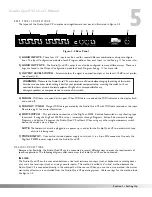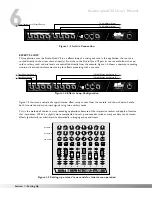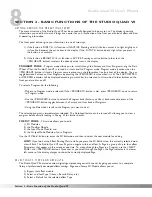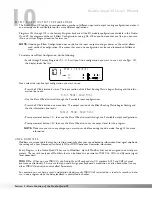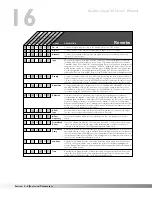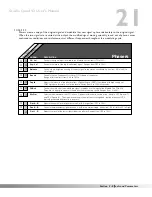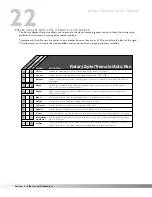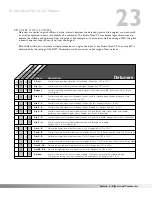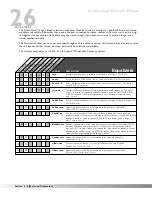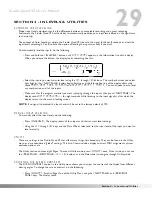
16
Gated Reverb
Stereo Gated Reverb
Stereo Dual Reverb
Dual Reverb
Stereo Reverb
Reverb
Type
Selects the Module's reverb type. Reverbs can be one of ten reverb types or variations,
including Studio Room, Wood Room, Vocal Plate, Concert Hall, Plate Reverb, Chamber,
Cathedral, Arena, Cement Shelter, or Infinite Spring. Each room type has a different decay
range (just as real rooms do), so changing TYPE also changes the decay time of the room.
Gated reverbs can be one of twelve different types, including Flat, Shelf,Decaying Linear,
Decaying Logarithmic, Decaying Exponential, Decaying Sine, Reverse Linear, Reverse
Logarithmic, Reverse Exponential, Reverse Sine, Peaking Linear, and Peaking Exponential.
Density
Controls the number of discrete room wall reflections during the early portions of DECAY.
Higher settings produce more reflections while low settings yield fewer initial wall echoes.
Use this control in conjunction with DISPERSION to build or reduce the thickness of early
reflection clusters heard near the beginning of the reverberation. Varies from 0% to 99%.
PARAM.
DESCRIPTION
Reverbs
Diffusion
Simulates the presence of different room materials by controlling the smoothness of
reverberations through the course of DECAY. Low DIFFUSION settings are great for
simulating hard, flat surfaces while higher DIFFUSION settings can be used to simulate the
presence of irregular surfaces in the room such as natural rock masonry or man-made
diffusers. Unlike flat surfaces, these materials reflect (diffuse) the sound in many directions
because of the irregularity of the surfaces themselves. This builds smoothness over the
reverb progression. Ranges from 0% to 99%.
Dispersion
Controls the distance (time) between the echoes set by DENSITY. If DENSITY is set low
and DISPERSION is set high, the initial room echoes can be heard as discrete echoes
followed by smoother room reverberations. Set DISPERSION low for a dense cluster of
reflections during the early portions of DECAY. Varies from 1 to 5.
Adjusts how quickly the room absorbs the high-frequency reverberations. In a real room,
absorptive materials can be used to dampen the natural high-frequency reverberations of
the room. High settings of DAMP cause the reverberations to darken tonally and become
less defined over the course of DECAY. Low settings cause less dramatic room effects on
the tone of the reverberations. Ranges from 1 to 7.
FX: Lvl
Controls the signal input level fed to the Module. Varies from OFF to 100%.
Dry: Lvl
Controls the level of the dry (uneffected) signal. Ranges from OFF to 100%.
Balance
Controls the left/right positioning of the dry signal in the stereo soundfield. Varies from
-99 (all left) to 99 (all right).
LowPass
Appears only in Gated Reverbs. Selects the frequency above which all frequencies are
rolled off. This control can be used to darken the response of bright-sounding gated
reverbs. Ranges from 100 Hz to 8 kHz in the Gated Reverb and from 100 Hz to 20 kHz in
the Stereo Gated Reverb.
Room Echo
Time
Appears only in Gated Reverbs. Controls the length of the gated reverb in milliseconds
(much like the DECAY control of a normal reverb). Ranges from 25 milliseconds to 300
milliseconds (or 500 milliseconds on the Stereo Gated Reverb).
✓
✓
✓
✓
✓
✓
✓
✓
✓
✓
✓
✓
✓
✓
✓
✓
✓
✓
✓
✓
✓
✓
✓
✓
✓
✓
✓
✓
✓
✓
✓
✓
✓
✓
✓
✓
✓
✓
✓
✓
✓
✓
✓
✓
✓
X-Over
Type
Selects which crossover type will be used for the Primary and Secondary reverb stages.
The two crossover types are High Pass (HP) and Low Pass (LP).
✓
✓
X-Over
Frequency
Selects the Frequency where the crossover begins to function. Ranges from 25Hz to
20kHz.
✓
✓
✓
Prim & Secd
X-Over
These two Parameters allow the crossover to be turned On or Off for each reverb stage.
When Off, that particular reverb stage will be full bandwidth, otherwise its frequency
response is limited by the X-Over Type and Frequency Parameters.
✓
✓
Prim & Secd
Damp
Section 3 - Effects and Parameters
Studio Quad V2 User's Manual




